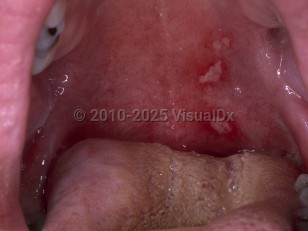Herpangina - Oral Mucosal Lesion
Alerts and Notices
Important News & Links
Synopsis

Herpangina is an infection caused by multiple types of coxsackie viruses (most often A5, A6, A8, A10, and A16), echoviruses, and enterovirus 71. It characteristically begins with acute onset of fever, headache, and sore throat complicated by dysphagia, loss of appetite, and less commonly stiff neck. In all cases, patients present with single or multiple yellowish-gray to white raised 1-2 mm papulovesicles in the throat, surrounded by a ring of intense erythema. Diffuse pharyngeal hyperemia is present. These lesions occur most frequently on the anterior faucial pillars, tonsils, uvula, and/or soft palate. Patients may have only one or two of these lesions, or the entire pharynx may be essentially covered with them. Clusters of lesions may coalesce. Lesions progress to ulceration, leaving shallow, slightly depressed grayish craters 2-4 mm in diameter. They spontaneously resolve in 5-10 days.
Herpangina may affect any age group but predominates among infants and children under the age of 5. Rare neurologic manifestations have been reported and include brain stem encephalitis. Febrile seizures have been reported.
Herpangina may affect any age group but predominates among infants and children under the age of 5. Rare neurologic manifestations have been reported and include brain stem encephalitis. Febrile seizures have been reported.
Codes
ICD10CM:
B08.5 – Enteroviral vesicular pharyngitis
SNOMEDCT:
186659004 – Herpangina
B08.5 – Enteroviral vesicular pharyngitis
SNOMEDCT:
186659004 – Herpangina
Look For
Subscription Required
Diagnostic Pearls
Subscription Required
Differential Diagnosis & Pitfalls

To perform a comparison, select diagnoses from the classic differential
Subscription Required
Best Tests
Subscription Required
Management Pearls
Subscription Required
Therapy
Subscription Required
References
Subscription Required
Last Updated:05/20/2013
Herpangina - Oral Mucosal Lesion

